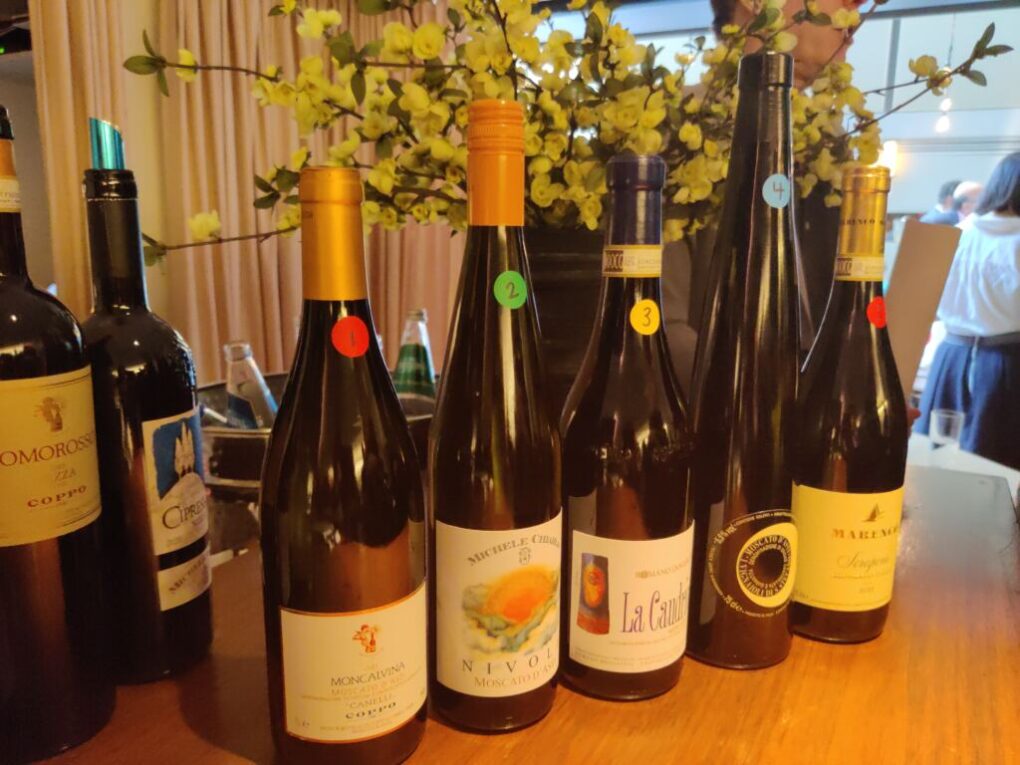
The northwest Italian region of Piedmont, located among the foothills of the Alps, is renowned for its picturesque landscape, historic cities such as Turin, and its exceptional wines. Asti, an area lying within Piedmont, is well-known for its sweet, frizzante (lightly sparkling) Moscato d’Asti wines.
Moscato d’Asti is made from the white grape Moscato Bianco. The cultivation of Moscato grapes in Asti can be traced back to ancient times. In fact, Moscato was the first varietal to be planted for the purpose of making wine. Moscato d’Asti gained recognition as a distinctive wine sometime in the 19th century. Its delicate effervescence and aromatic qualities helped to distinguish it from drier spumante and still wines.
The production of Moscato d’Asti involves the fermentation of partially fermented grape must, which results in a lower alcohol content compared to fully fermented wines. The fermentation process is stopped before completion, allowing the wine to retain a portion of its natural sugars and aromatic compounds. This gives Moscato d’Asti its characteristic sweetness and aromatic profile. It has notes of ripe peach, apricot, orange blossom, and hints of nuts and dried vegetation.
Asti Spumante, commonly referred to as Asti, is another sparkling wine produced in the Asti region of Piedmont. It is made primarily from the Moscato Bianco grape variety using the Charmat method, where the secondary fermentation occurs in large pressurized tanks, instead of individual bottles. This process results in a slightly higher alcohol content, and a more pronounced effervescence, compared to Moscato d’Asti. Asti wines are typically slightly sweeter and less fizzy than Moscato d’Asti.
The wines are best consumed when young to preserve their fresh and vibrant flavors. Nevertheless, both Moscato d’Asti and Asti can be aged to reveal an evolution in the flavor profile, where citrus and summer-fruit dominant aromas and notes, give way to that of sliced almonds, hazelnuts, balsamic, and petrol.
The Consorzio dell’ Asti (Consortium for the Protection of Asti DOCG) oversees the production of Moscato d’Asti and Asti wines, and guarantees their provenance.
The delicate effervescence, and fruit and honey-driven sweetness of Moscato d’Asti and Asti make them highly adaptable to a wide range of dishes. They are traditionally enjoyed as aperitifs, or dessert wines that are paired with fruit-based desserts, and creamy pastries. But they also make ideal complements to spicy fare.

A masterclass and tasting of the following five Moscato d’Asti was held at Il Gattopardo Restaurant in New York City.
Coppo, Moncalvina, Moscato d’Asti, DOCG, 2022
Straw yellow color with slight greenish reflections. Fresh and aromatic, with white flower, peach, and pear notes. Pairs well with cakes, cookies, and fruit-based desserts.
Michele Chiarlo, Nivole, Moscato d’Asti DOCG, 2022
Brilliant straw yellow color. Fresh, creamy, and fragrant, with a fine mousse, and floral and orchard fruit notes. Pairs well with classic Italian desserts such as zabaione and paste di meliga.
Caudrina, Moscato d’Asti DOCG, La Caudrina, 2022
Deep straw yellow color. Aromatic, with a delicate sweetness, a soft acidity, and orange, pear, and apricot notes. Makes a great complement to traditional Italian holiday treats like panettone, and Easter colomba.
I Vignaioli di Santo Stefano-Ceretto, Moscato d’Asti DOCG, 2022
Pale yellow color. (organic and biodynamic)
Delicate, with a soft acidity, balanced alcohol and sugar, and sweet melon, orange blossom, and jasmine, as well as honeysuckle notes.
Pairs well with gelato, cheeses, and roasted hazelnuts.
Marenco, Moscato d’Asti DOCG, Scrapona, 2022 (organic)
Golden yellow color.
Fresh and elegant, with a delicate perlage, and lime, apricot, and orange blossom, as well as passion fruit notes. Makes a great complement to tempura, light cheeses, and spicy food, in addition to marzipan, fruit salads, and macaroons.

Be First to Comment